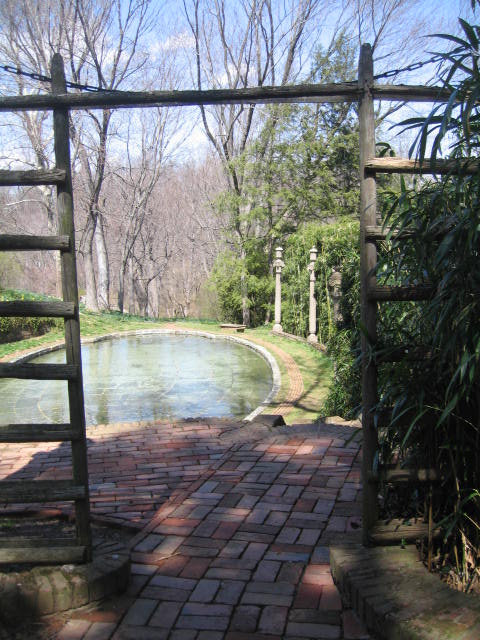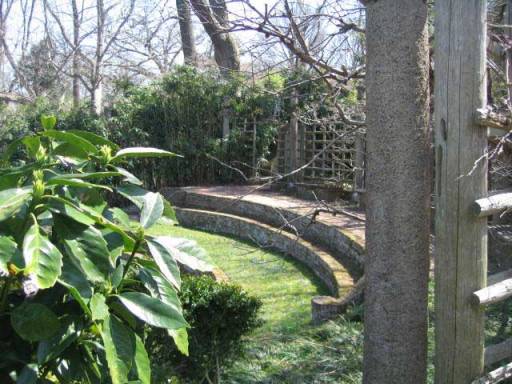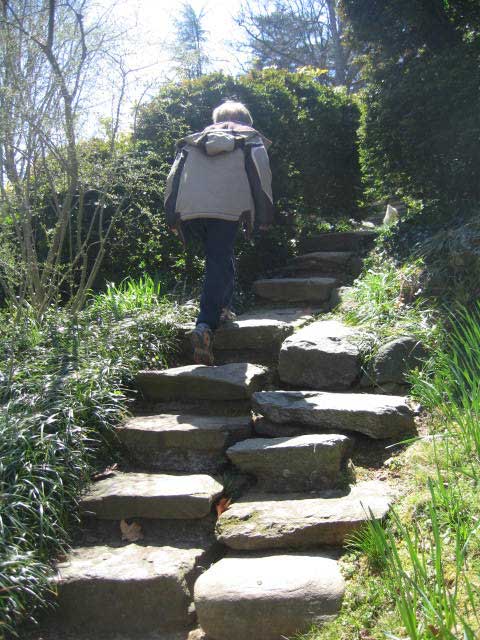One of Beatrix Ferrand’s most famous projects is the garden at Dumbarton Oaks in Washington DC, which is known for its lavish garden rooms and magnificent attention to detail. As you can see in the map below, each garden “room” has its own name — Rose Garden, Urn Terrace, Pebble Garden, etc. — and each room is masterfully designed and delightful to experience.
What I have highlighted in yellow on the map, though, are actually my favorite parts of Dumbarton Oaks. You will notice they are not the individual gardens at all, but rather the spaces between the gardens, the transitions. To me, these spaces have always been the most compelling aspect of Dumbarton Oaks, and they are evidence that Beatrix Farrand was a freakin’ genius.
Farrand seemed to put as much thoughtful design into the garden’s transitional spaces as she did into the rooms themselves. For instance, look how this narrow stone stairway beckons you up the hill….
At the top of the steps you find yourself in the Arbor Terrace, a shady and restful spot with a grotto-like fountain:
Farrand was completely masterful in her use of sound and smell in these transition areas. As you travel the paths between gardens, you can often hear the sound of water trickling or gurgling from an area that you can’t yet see. For example, as you walk up this path, you can hear the sound of a fountain in the distance….
Turn left at the end of the wall and you enter the famous Ellipse Garden and ah-ha! there’s the fountain:
Farrand also lined these transitional paths with fragrant shrubs like lilac and honeysuckle, and she paid just as much attention to the walls, paving, and plantings in these “in-between” areas as she did to the major garden areas. For example, here is the stairway leading to the pool — a feature more interesting than the pool itself:
Below is a picture of the path on the way to Lover’s Lane (a shallow pool hidden in the woods). At the end of the path, a statue of Pan points the way to…
the pool, where undoubtedly you will be getting up to no good with your sweetheart:
You have to love a garden that encourages mischievous behavior (although in early April when I visited this area doesn’t have a very secluded feel — gotta wait for the leaves to fill in.)
Here is a little path that jigs off to the side behind some large evergreens. The beautiful tiled roof pokes up and entices you over:
Turn left at the end of the path and you get a nice view of the cutting garden (just getting going) with the Prunus Walk in the distance:
And scattered throughout the entire garden are curving brick paths lined with boxwood, or rustic stairways that lead to hidden terraces, or peek-a-boos of secret spaces glimpsed between evergreens:
Please check out other perspectives on “Transitions” from my fellow Roundtablers:
Jocelyn Chilvers : The Art Garden : Denver, CO
Deborah Silver : Dirt Simple : Detroit, MI
Scott Hokunson : Blue Heron Landscapes : Granby, CT












Pingback: Transitions! | Garden Designers Roundtable
Pingback: Garden Designers Roundtable – Transitions… | Blue Heron Landscapes
Thanks so much for this post! I have never been to Dumbarton Oaks, but have seen photos of many of the iconic spaces, which are great, but — there’s something wonderful about creating a sense of anticipation, or mystery, or invitation before or after you get to those better-known places. Seeing photos of some of these more incidental spots is a fine way to get a fuller sense of the whole place,and your observations are a treat. Thanks!
Exactly…”anticipation” is a word I should have used in the post. One of the hallmarks of a great garden.
One image that has been forever implanted in my mind is that horseshoe staircase with the white fountain in the middle that one summer was filled with Maidenhair Fern. The delicate light green was perfect against the white back drop. I have also seen it in Japanese Iris which was nice as well. I also love the Beech Terrace but you are right that the transitions in this garden are masterful!
Heather…I can just imagine that staircase filled with maidenhair fern…would be gorgeous.
Pingback: Garden Designers Roundtable ~ Transitions | A Garden of Possibilities
A wonderful series of lessons here, Mary! I especially like the idea of using sound as the transitional element of change from one space to another. Genius, yes!
Thanks, Jocelyn. Dumbarton Oaks is definitely one of those gardens that you can learn a ton of design lessons from.
Pingback: The Garden Designers Roundtable: Transitions — J Peterson Garden Design
Never been or seen this treasure – thanks for showing more of what we miss out on hearing only of DC area politics, etc! Frolicking in that pool w/ one’s special someone…that’s the ticket.
David: Washington is really a great city aside from the whole “federal government” thing.
Mary, What luscious photos. Each one is more interesting than the next but I do love the stairway leading to the pool. I’m adding the Dunbarton Oaks to my must-see list.
Definitely do, Debbie! April is a wonderful time to see it, too!
Hi Ian,The headers hash works in a similar way to the params and session hashes. As it is based on the template, it may need to render in the controller actions so that it has access to your model, unless you hardcode a filename I suppose. To answer your question, it depends on what controllers need this code; you could have a berefe/aftor_filter for each method in a particular controller.Let me know how you get on.
One of my favorite public gardens, what about the incredible katsura tree near the entrance, I visit as often as possible. The paths, structures, etc, great in every season. Thanks for posting this.
You’re very welcome, Erica. I love that Katsura tree, too.I always want to climb on it but of course the staff frowns on that (understandably so). I soooooo miss your show!